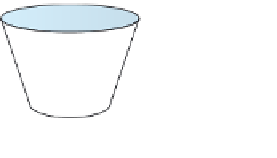Geoscience Reference
In-Depth Information
even though it can hold 2 cups. With respect to the atmosphere,
this ratio is usually expressed as a percentage and is calculated as
Relative humidity (%)
=
(
Speciic humidity
)
Maximum humidity
×
100
RH (%)
=
(SH / MH)
×
100
The following example should make these humidity con-
cepts clearer. Let's say that a given mass of air at a certain tem-
perature can potentially hold 2 units of water vapor, as seen
in the simplified diagram in Figure 7.7a. In other words, its
maximum humidity is 2 units.
But how much water vapor is actually there—in other
words, what is the specific amount of vapor present? Well,
imagine that the mass of air contains a 1/2 unit of water vapor,
as in Figure 7.7b. Under these circumstances, you could say that
the specific humidity is a 1/2 unit. In this simplified example,
you can conclude that the volume of air actually has a 1/2 unit
but has a potential of 2 units, so the air contains the water vapor
that it can
potentially
hold (see Figure 7.7c). In other words,
the
relative humidity is 25%
.
Humidity is usually measured with an instrument known as
a
sling psychrometer
(Figure 7.8). This measurement system uses
two thermometers—a wet bulb and a dry bulb—mounted side by
side on a small platform. The wet bulb is covered with a cotton
sleeve and moistened with water of room temperature, whereas
the dry bulb remains dry. At this point, the temperature of the two
bulbs is the same. The two thermometers are then whirled in the
air. If the surrounding air is not saturated, water from the moist
Figure 7.8 Sling psychrometer.
This system uses a pair
of thermometers that detect the amount of cooling due to
evaporation. The dry-bulb thermometer shows the actual
temperature, whereas the wet-bulb thermometer indicates the
amount of cooling.
cotton sleeve on the wet bulb will evaporate. As a result, heat is ab-
sorbed from the bulb, and thus the temperature of the bulb drops.
In these conditions, the wet-bulb and dry-bulb temperatures are set
on a scale, and the relative humidity is then calculated. The amount
of evaporation, and subsequent cooling of the wet bulb, increase
when the air is progressively drier. On the other hand, if the air is
saturated, then no cooling of the wet bulb takes place because no
water is evaporated from the cotton sleeve, and the thermometers
show the same temperature. Other devices can measure relative
humidity directly. One such system absorbs an amount of water
vapor that depends on the relative humidity. No matter how rela-
tive humidity is measured, however, when the relative humidity is
low the air is relatively dry. In contrast, when relative humidity is
high, the air is close to being saturated. And always remember that
warm air can hold more water vapor than cold air.
You can see how specific humidity changes with air
temperature by examining Figure 7.9a, which shows the geo-
graphic relationship of specific humidity to latitude in the
middle atmosphere during January 2004. Specific humidity is
greater in the lower latitudes where the temperatures are gener-
ally warm. In contrast, the specific humidity is relatively low at
the higher latitudes because air temperature is relatively cold.
A common mistake many students make is to assume that the
relationship illustrated in Figure 7.9a means that relative humid-
ity varies in the same geographic pattern, with relative humidity
being higher at lower latitudes than at high latitudes. Although
this pattern may sometimes follow, it is not necessarily so. In fact,
the relative humidity at higher latitudes is typically higher than in
warmer zones. Figure 7.9b shows the nature of this geographic
distribution. Why do you suppose this inverse relationship exists?
The reason is that cold air can hold less water vapor than warm air.
So even though the high latitudes typically contain less water va-
por, the inherently colder air is proportionately closer to saturation
than the warmer air at lower latitudes. Thus, the relative humidity
is usually greater at high latitudes compared to low latitudes.
(a)
Maximum humidity = 2 units
1
—-
(b)
Specific humidity =
unit
(c)
Relative humidity = 25%
Figure 7.7 Hypothetical humidity values.
(a) In this example,
the maximum humidity is 2 units of water vapor. (b) In this ex-
ample, the specific humidity is ½ unit. (c) The mass of air can hold
2 units of water vapor, but only ½ of a unit is present. Thus, the
relative humidity is 25%.



































































